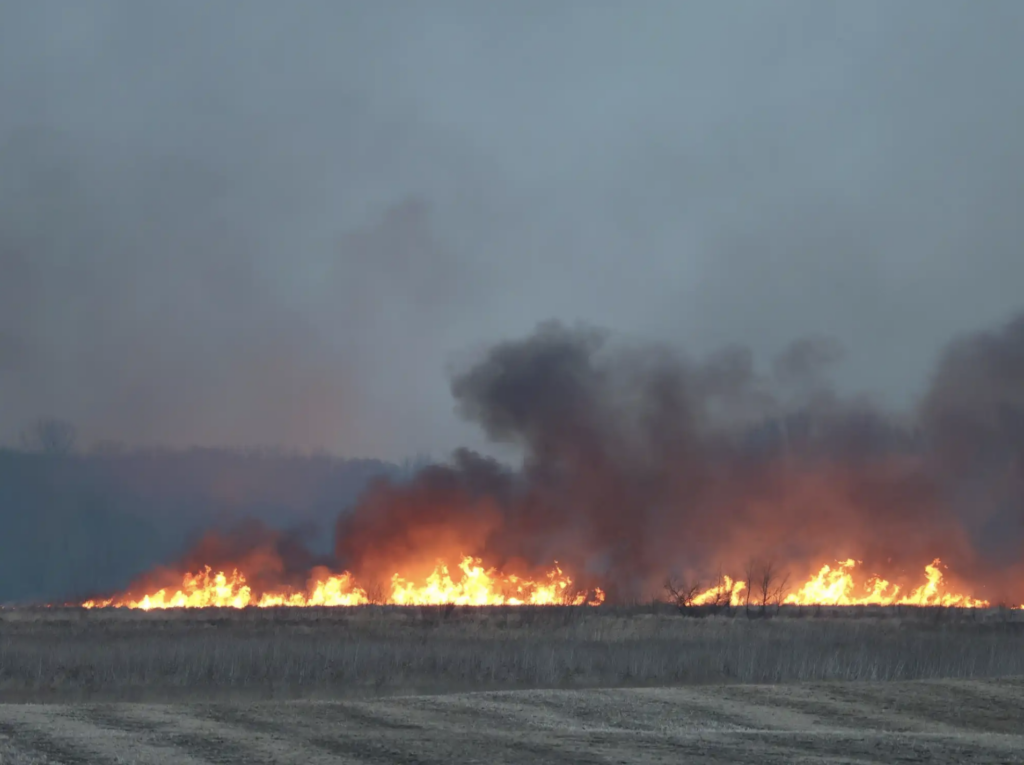Update: Wildfires burn hundreds of acres in southern, western Minnesota
Published 8:19 pm Sunday, March 3, 2024

- Plumes of dark smoke rise into the sky as a wildfire burns a few miles northeast of Waseca on Sunday. Andrew Krueger/MPR News
|
Getting your Trinity Audio player ready...
|
By Cari Spencer and Nicole Ki, Minnesota Public Radio News
Wildfires in southern and western Minnesota left at least three people injured and burned more than 3,000 acres Sunday amid warm weather, gusty winds and low humidity.
State officials said at least eight wildfires were reported from southern Minnesota and the Twin Cities metro area and northwest to Moorhead. Six totaled less than two acres, but two — near Fergus Falls and Waseca — burned several thousand acres.
In western Minnesota, the Fergus Falls Fire Department reported that a fast-moving wildfire in Western Township, southwest of Fergus Falls, burned 2,300 acres on Sunday. Officials said it was contained as of Sunday night, with Minnesota DNR and U.S. Fish and Wildlife Service crews monitoring areas that were still smoldering.
Meanwhile, around noon Sunday, a wildfire ignited north of Waseca, swelling to more than 500 acres by late afternoon as it spread across fields and wetlands, according to the Minnesota Department of Natural Resources.
The fire was brought under control Sunday night after burning an estimated 1,000 acres.
The Waseca Fire Department said one resident and two firefighters were injured during the fire. The two firefighters were treated and released; there was no update Monday on the resident’s condition. Some homes were evacuated but no buildings were damaged, the fire department said. The cause of the fire is under investigation.
Leanne Langeberg, a public information officer with the Minnesota Interagency Fire Center, said a helicopter would continue water drops Monday, in order to put out “lingering hot spots.”
“With the conditions coming down last night, there hasn’t been any reports of growth to the fire,” she said.
Twelve fire departments responded to the fire near Waseca, with support from the DNR and U.S. Fish and Wildlife Service, and other local agencies. In addition to the helicopter, two planes were dispatched to lay down fire retardant, Langeberg said.
The Minnesota Pollution Control Agency issued an advisory Sunday, saying the wildfire could affect air quality along the Interstate 35 corridor as far north as the Twin Cities. Shifting winds later pushed the smoke to the east.
The fire near Waseca started as a small brush fire, growing amid ideal fire conditions. Sunday’s weather conditions prompted officials to issue the first red flag warning of the year in Minnesota, signaling ideal conditions for flames to easily spread quickly out of control.
Langeberg said the season’s first red flag warning usually is not issued until late March and early April, but the lack of snow cover this winter spurred an earlier warning.
“If we continue on the drier pattern, we’re likely to have a more-active spring wildfire season this year,” said Langeberg. “What we’re seeing this time of year is a lot of the grasses that were left over from last year are now once again exposed and they’ve had the whole winter to dry out in here. And when you get a heat source that touches down on those grasses, a fire can ignite.”
Langeberg said having so many wildfires already is “traditionally very uncommon” because there is usually snow still covering the landscape across Minnesota. If a dry spring continues, Langeberg said the state may reach out for resources from national partnerships.
“We need to be very mindful of the dry conditions that exist this spring. And really do our best to be mindful of how our activities involving any type of heat source can quickly spread into an unintended wildfire,” Langeberg said. “For those that do spot an unintended wildfire, call 911, immediately, because trained firefighters can respond quickly to those types of scenarios.”


